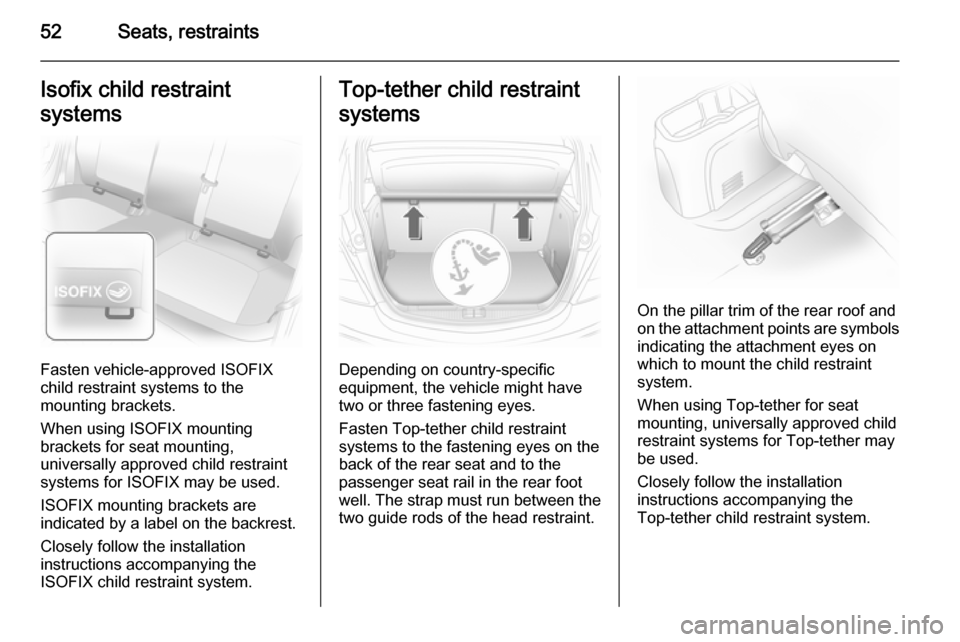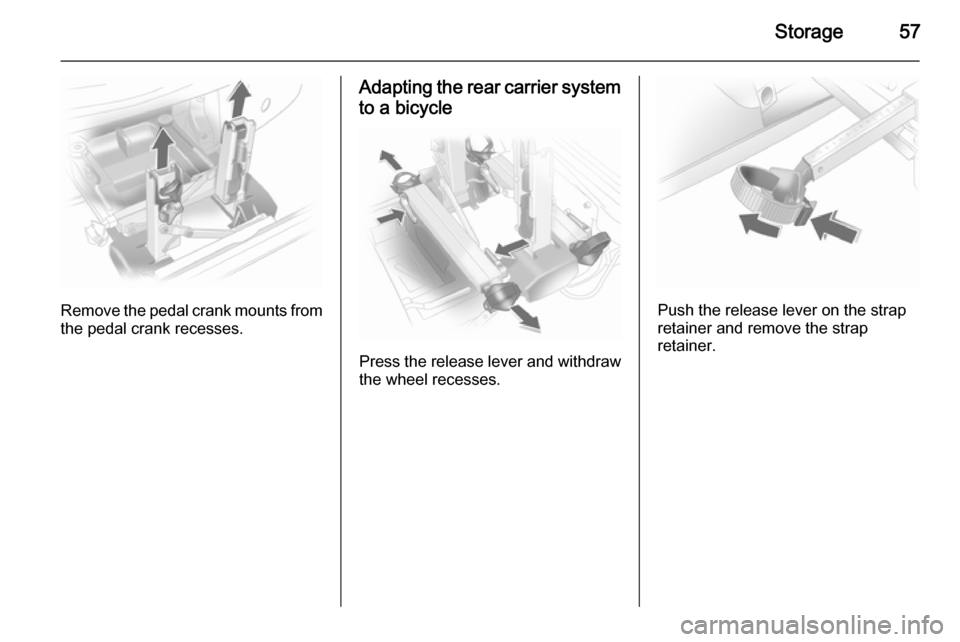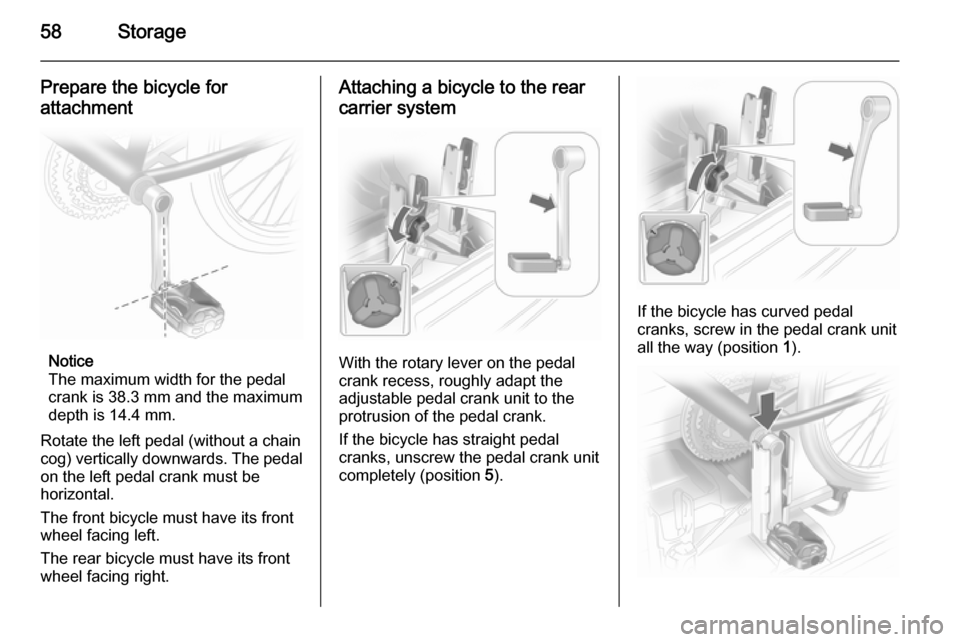VAUXHALL CORSA 2014.5 Workshop Manual
Manufacturer: VAUXHALL, Model Year: 2014.5, Model line: CORSA, Model: VAUXHALL CORSA 2014.5Pages: 231, PDF Size: 6.8 MB
Page 51 of 231

Seats, restraints49Child restraint installation locationsPermissible options for fitting a child restraint system
Weight and age class
On front passenger seat
On rear outboard seatsOn rear centre seat
activated airbagdeactivated airbagGroup 0: up to 10 kg
or approx. 10 monthsXU 1UXGroup 0+: up to 13 kg
or approx. 2 yearsXU 1UXGroup I: 9 to 18 kg
or approx. 8 months to 4 yearsXU 1UXGroup II: 15 to 25 kg
or approx. 3 to 7 yearsXXUXGroup III: 22 to 36 kg
or approx. 6 to 12 yearsXXUX1=If the child restraint system is being secured using a three-point seat belt, move seat height adjustment to uppermost position and ensure that vehicle seat belt runs forwards from the upper anchorage point. Adjust seat backrest
inclination as far as necessary to a vertical position to ensure that the belt is tight on the buckle side.U=Universal suitability in conjunction with three-point seat belt.X=No child restraint system permitted in this weight class.
Page 52 of 231

50Seats, restraints
Permissible options for fitting an ISOFIX child restraint systemWeight classSize classFixtureOn front passenger seatOn rear outboard
seatsOn rear centre seatGroup 0: up to 10 kg
or approx. 10 monthsEISO/R1ILILXGroup 0+: up to 13 kg
or approx. 2 yearsEISO/R1ILILXDISO/R2XXXCISO/R3XXXGroup I: 9 to 18 kg
or approx. 8 months to 4 yearsDISO/R2XXXCISO/R3XXXBISO/F2IL, IUFIL, IUFXB1ISO/F2XIL, IUFIL, IUFXAISO/F3XXXGroup II: 15 to 25 kg
or approx. 3 to 7 yearsXILXGroup III: 22 to 36 kg
or approx. 6 to 12 yearsXILX
Page 53 of 231

Seats, restraints51
IL=Suitable for particular ISOFIX restraint systems of the 'specific-vehicle', 'restricted' or 'semi-universal' categories.The ISOFIX restraint system must be approved for the specific vehicle type (Not available on the front passenger
seat in the Corsa VXR).IUF=Suitable for ISOFIX forward-facing child restraint systems of universal category approved for use in this mass group
(Not available on the front passenger seat in the Corsa VXR).X=No ISOFIX child restraint system approved in this weight class.
ISOFIX size class and seat device
A – ISO/F3=Forward-facing child restraint system for children of maximum size in the weight class 9 to 18 kg.B – ISO/F2=Forward-facing child restraint system for smaller children in the weight class 9 to 18 kg.B1 – ISO/F2X=Forward-facing child restraint system for smaller children in the weight class 9 to 18 kg.C – ISO/R3=Rear-facing child restraint system for children of maximum size in the weight class up to 18 kg.D – ISO/R2=Rear-facing child restraint system for smaller children in the weight class up to 18 kg.E – ISO/R1=Rear-facing child restraint system for young children in the weight class up to 13 kg.U=Universal suitability in conjunction with three-point seat belt.X=No child restraint system permitted in this weight class.
Page 54 of 231

52Seats, restraintsIsofix child restraint
systems
Fasten vehicle-approved ISOFIX
child restraint systems to the
mounting brackets.
When using ISOFIX mounting
brackets for seat mounting,
universally approved child restraint
systems for ISOFIX may be used.
ISOFIX mounting brackets are
indicated by a label on the backrest.
Closely follow the installation
instructions accompanying the
ISOFIX child restraint system.
Top-tether child restraint
systems
Depending on country-specific
equipment, the vehicle might have
two or three fastening eyes.
Fasten Top-tether child restraint
systems to the fastening eyes on the
back of the rear seat and to the
passenger seat rail in the rear foot
well. The strap must run between the
two guide rods of the head restraint.
On the pillar trim of the rear roof and
on the attachment points are symbols
indicating the attachment eyes on
which to mount the child restraint
system.
When using Top-tether for seat
mounting, universally approved child restraint systems for Top-tether may
be used.
Closely follow the installation
instructions accompanying the
Top-tether child restraint system.
Page 55 of 231

Storage53StorageStorage compartments................53
Load compartment .......................63
Roof rack system .........................67
Loading information .....................68Storage compartments9Warning
Do not store heavy or sharp
objects in the storage
compartments. Otherwise, the
storage compartment lid could
open and vehicle occupants could be injured by objects being thrown
around in the event of hard
braking, a sudden change in
direction or an accident.
Glovebox
The glovebox features:
■ a card holder in cheque card format
■ a pen holder
■ pocket torch holder
■ a key adapter for the locking wheel
bolts
The glovebox should be closed whilst driving.
Cupholders
A cupholder is located in the front of
the centre console.
In the 3-door passenger vehicle: also
located on the side of the rear seat.
Page 56 of 231

54StorageUnderseat storage
Lift at recessed edge and pull out.
Maximum load: 1.5 kg. To close, push in and engage.
Rear carrier system
The rear carrier system (Flex-Fix
system) allows bicycles to be
attached to a pull-out carrier
integrated into the vehicle floor. The
transportation of other objects is not
permitted.
The maximum load of the rear carrier
system is 40 kg.The maximum load
per bicycle is 20 kg.
If not in use, the carrier system can be slid back into the vehicle floor.
There must not be any objects on the
bicycles that could become loose
during transportation.
Caution
Do not attach bicycles with carbon pedal cranks to bicycle carriers.
The bicycles might get damaged.
Extending
Open the tailgate.
9 Warning
No people may remain in the
extension zone of the rear carrier system, risk of injury.
Page 57 of 231

Storage55
Pull release lever up. The system
disengages and travels quickly out of
the bumper.
Completely pull out the rear carrier
system until you hear it engage.
Ensure that it is not possible to push in the rear carrier system without
pulling the release lever again.
9 Warning
It is only permissible to fit objects
to the rear carrier system if the
system has been correctly
engaged. If the rear carrier system
will not engage correctly, do not fit
objects to the system and slide the system back. Seek the assistance
of a workshop.
Install the tail lamps
First remove the rear ( 1), then the
front ( 2) tail lamp from the recesses.
Open out the lamp support on the
back of the tail lamp completely until
it engages.
Page 58 of 231

56Storage
Push the clamping lever down and
push the lamp support into the
retainer until it engages.
Perform this procedure for both tail
lamps.
Check the cable and lamp position to
make sure these are correctly
installed and are securely located.
Lock the rear carrier system
Swivel the left clamping lever ( 1) first,
followed by the right clamping lever
( 2 ) until they stop. Both clamping
levers must point backwards,
otherwise safe functionality is not
guaranteed.
Notice
Close the tailgate.
Unfold pedal crank recesses
Fold one or both pedal crank
recesses upwards until the diagonal
support engages.
Page 59 of 231

Storage57
Remove the pedal crank mounts from
the pedal crank recesses.
Adapting the rear carrier system
to a bicycle
Press the release lever and withdraw
the wheel recesses.
Push the release lever on the strap
retainer and remove the strap
retainer.
Page 60 of 231

58Storage
Prepare the bicycle for
attachment
Notice
The maximum width for the pedal
crank is 38.3 mm and the maximum
depth is 14.4 mm.
Rotate the left pedal (without a chain
cog) vertically downwards. The pedal
on the left pedal crank must be
horizontal.
The front bicycle must have its front
wheel facing left.
The rear bicycle must have its front
wheel facing right.
Attaching a bicycle to the rear
carrier system
With the rotary lever on the pedal
crank recess, roughly adapt the
adjustable pedal crank unit to the
protrusion of the pedal crank.
If the bicycle has straight pedal
cranks, unscrew the pedal crank unit
completely (position 5).
If the bicycle has curved pedal
cranks, screw in the pedal crank unit all the way (position 1).